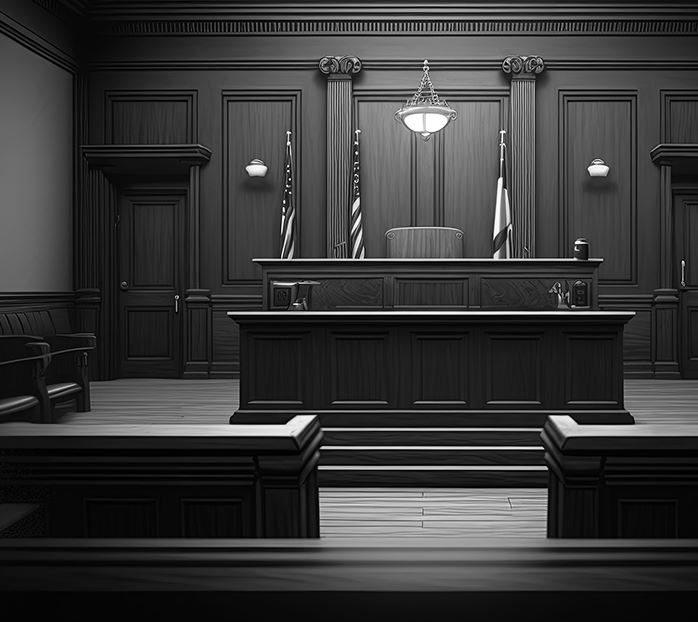CRIMINAL TRIAL PROCESS IN CALIFORNIA
Understand Your Criminal Defense Case
If you have been arrested for a crime, no doubt you may be curious about what you will be facing. Despite the complexity of our country’s legal system, most criminal trials are conducted similarly. Our attorney explains how the trial is held and what each step of the process entails. Understanding the criminal trial system not only prepares you for what is to come, but can also help you get a better grasp of your own case and the defense strategies that will be used to help protect your rights.
For more information about the criminal process, contact The Law Offices of Jacqueline Goodman.
SELECTING A JURY
Except in rare cases, the first step of the trial process is selecting jury members. The selection is conducted with the judge, the plaintiff’s attorney, and the defendant’s attorney. They ask the potential jurors a serious of questions pertaining to the case, including questions about ideological opinions and life experiences.
A potential juror may not be selected for a couple of reasons:
- The judge excused the potential juror due to their answers
- The defense or prosecution may exclude an individual through use of “peremptory challenges” and challenges “for cause”
If a potential jury member gives answers that seem biased or to favor a certain side unfairly, the prosecution or defense may request that individual not be used in the trial. There are only a certain number of jurors that may be excluded. Once both parties are content with the unbiased jurors that have been selected, the trial may begin.
OPENING STATEMENTS
The trial begins with the prosecutor and the defense presenting beginning arguments. Witnesses and evidence are usually not presented during this time.
The prosecutor, on behalf of the government, must prove that the defendant is guilty. For this reason, often the prosecution’s opening statement is given first. The purpose of the opening statement for the prosecution is to state the facts of the case and prove how and why the defendant committed the crime.
The defense uses the opening statement to refute the prosecution’s facts and instill doubt that the defendant is guilty beyond a reasonable doubt.
PUT YOUR TRUST IN A PROVENCRIMINAL DEFENSE LAWYER
Attorney Jacqueline Goodman has more than 20 years of experience in criminal defense. As the President of California Attorneys for Criminal Justice and the standalone vice chair of the Sex Offenses division of the National Association of Criminal Defense Lawyers, she has been at the forefront of criminal law in California and across the nation.
Schedule an initial consultation at The Law Offices of Jacqueline Goodman in Orange County. Everyone deserves a chance to defend themselves.
It is with tremendous thanks and a grateful heart that we let you know how much we appreciated your expertise, advice and phone calls on [client's name] behalf. You are a person of service and dedication.
- Former client’s parents
I don't know where to start. Honestly, I don't think I could possibly write anything that would come close to describing Mrs. Goodman's Skill as a Lawyer , she truly is remarkable at what she does. Do yourself a favor, if your in a bind, and are looking for a well respected lawyer that can produce results.... Call Jacqueline! I…
- Sharif A.
Ms Goodman and her staff were beyond helpful. I was in an extremely difficult situation that I hadn’t been in before and needed help. I was referred to Jackie and her office who were extremely helpful. Jackie and her team were extremely empathetic and knowledgeable. They were quick to respond, took action, and kept me informed. Thank you Ms Goodman…
- Nick K.
Ms.Goodman has been an amazing and thorough lawyer representing my family. She has shown up to each court date, being prepared and ready to speak to the judge. She has been a great communicator with my family and kept us informed along the way. She is authentic, and will go the long mile on your case. Choose her to represent…
- Elizabeth E.
I needed an appointment with Ms. Jacqueline Goodman and it was urgent. The best part was that she called me back immediately and I did not have to drive an hour to see her. The first meeting is free and she spoke with me for a lengthy time and she made me feel like for the first time in seeking…
- Mary P.
Ms Goodman was excellent an very professional. She took the time to understand our concerns an worries. I had 2 really bad cases facing 10+ years for trafficking, sales, an distribution between the both ... she was able to get me the best deal an walked away with probation an a new look at life. I will always recommend her…
- Joe G.
Ms. Goodman and her team is by far the best in Southern California. I literally had zero hope of getting anything but prison time on my current case and Ms. Goodman somehow got me an interview for probation. I can say it hasn’t been easy and she’s been doing a lot out of love more than any other attorney would…
- Former Client
The court was offering 9 years for 459pc. After retaining her I got the deal I wanted and even better I was free after serving just 2 years. She's an amazing attorney that you can count on.
- Aliya J.
I can't even begin to express how amazing Jacqueline was when I worked with her for a close friend's case. She was always a quick text away, and when we worried she was the vote of confidence we needed to keep going. Her office staff was also SO easy to work with. Her closing statement moved me, the family, and…
- Caleigha C.
Best lawyer! Jacqueline Goodman is an amazing lawyer, she knows her law well. She helped my brother out of a messy situation and she was always easy to contact and gave me all the information that came her way.
- Rosie C.
Jacqueline, was very professional, and knowledgeable. She listened closely, as we discussed my case. I could tell She truly cared about me. I was very pleased the outcome, and would strongly recommend Her. Honest, hard working, and compassion, would describe, Jacquie.
- Dorian C.
Ms. Jacqueline Goodman was a beacon of hope to my daughter at a time when options and hope seemed limited. Her hard work and dedication was an outcome of Excellence. Ms. Goodman’s attention to detail and knowledge of laws are truly unsurpassed. Thank you.
- Ralph S.
Jacqueline is the best! If any of my friends or family found themselves in a situation where they needed a Criminal Defense attorney I would highly recommend her. She and her staff are extremely professional and they know their stuff. I can't say enough good things!
- Travis H.
She was carring and attentive, always up front with information. She truly cares about her clients and works diligently to achieve the best possible outcome. My family and I truly admire and respect this amazing and talented lawyer. She is definitely someone you can count on for the best advice and outcome.
- Chip E.
Great attorney to work with. She's a boss and has some serious attorney swagger. When I walked into the court room with her, everybody stopped and starred. I felt like I was getting represented by a superstar attorney. She'll run circles around any DA.
- Marcus W.
WITNESS TESTIMONY AND CROSS-EXAMINATION
One major piece of evidence in a criminal trial is the witness testimony. Both the prosecution and the defense can call upon witnesses to support their case.
The witness testimony process is conducted as followed:
- The witness is sworn in after being called to the stand.
- The party that called the witness to the stand questions him or her. The direct examination is used to extract information that supports the party’s position.
- After the examination, the opposing party has a chance to cross-examine the witness. They attempt to weaken the testimony by pointing out holes and discredit the witness or account.
- When the cross-examination is completed, the original party has a chance to re-direct examination. They can ask questions that will repair the damage done to their case by the cross-examination.
Each side is given the opportunity to present and challenge evidence. When neither side has any more evidence to present or refute, both sides “rest” and the trial moves into closing arguments.


CLOSING ARGUMENTS
Very similar to opening statements, the prosecution and the defense are able to provide statements that summarize the case and the evidence they provided. It is the final chance for both parties to present statements to convince the jury in their favor.
DELIBERATION AND VERDICT
During the final stage, the judge provides the jury with instruction and they deliberate. The jury attempts to agree on whether or not the defendant is guilty or not guilty. Depending on the case, the deliberation process can last anywhere from a couple of hours to a couple of weeks.
In California, if the jury is unable to unanimously agree on a guilty or not guilty verdict (this is also known as a “hung jury”) a retrial will occur with a different jury.

